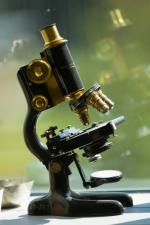|
This section contains 387 words (approx. 2 pages at 300 words per page) |
Marine microbiology refers to the study of the microorganisms that inhabit saltwater. Until the past two to three decades, the oceans were regarded as being almost devoid of microorganisms. Now, the importance of microorganisms such as bacteria to the ocean ecosystem and to life on Earth is increasingly being recognized.
Microorganisms such as bacteria that live in the ocean inhabit a harsh environment. Ocean temperatures are generally very cold--approximately 37.4° F (about 3° C) on average--and this temperature tends to remain the cold except in shallow areas. About 75% of the oceans of the world are below 3300 feet (1000 meters) in depth. The pressure on objects like bacteria at increasing depths is enormous.
Some marine bacteria have adapted to the pressure of the ocean depths and require the presence of the extreme pressure in order to function. Such bacteria are barophilic if their requirement for pressure is absolute or barotrophic if they can tolerate both extreme and near-atmospheric pressures. Similarly, many marine bacteria have adapted to the cold growth temperatures. Those which tolerate the temperatures are described as psychrotrophic, while those bacteria that require the cold temperatures are psychrophilic ("cold loving").
Marine waters are elevated in certain ions such as sodium. Not surprisingly, marine microbes like bacteria have an absolute requirement for sodium, as well as for potassium and magnesium ions. The bacteria have also adapted to grow on very low concentrations of nutrients. In the ocean, most of the organic material is located within 300 meters of the surface. Very small amounts of usable nutrients reach the deep ocean. The bacteria that inhabit these depths are in fact inhibited by high concentrations of organic material.
The bacterial communication system known as quorum sensing was first discovered in the marine bacterium Vibrio fischeri. An inhibitor of the quorum sensing mechanism has also been uncovered in a type of marine algae.
Marine microbiology has become the subject of much commercial interest. Compounds with commercial potential as nutritional additives and antimicrobials are being discovered from marine bacteria, actinomycetes and fungi. For example the burgeoning marine nutraceuticals market represents millions of dollars annually, and the industry is still in its infancy. As relatively little is still known of the marine microbial world, as compared to terrestrial microbiology, many more commercial and medically relevant compounds undoubtedly remain to be discovered.
|
This section contains 387 words (approx. 2 pages at 300 words per page) |


